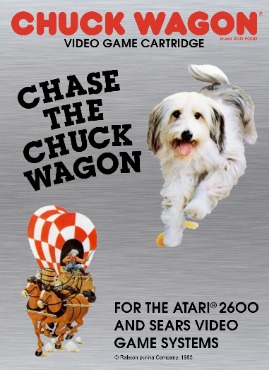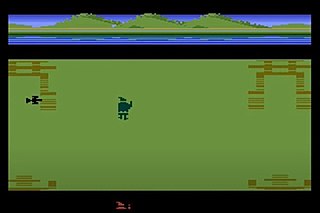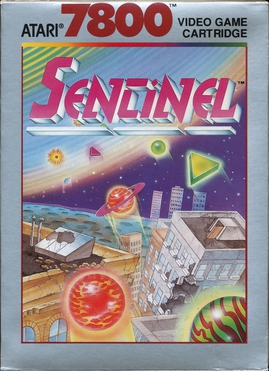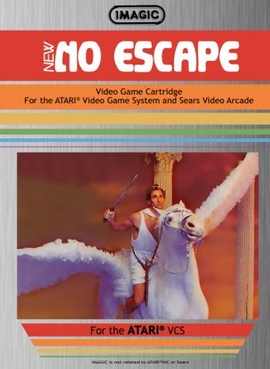
E.T. the Extra-Terrestrial is a 1982 adventure video game developed and published by Atari, Inc. for the Atari 2600 and based on the film of the same name. The game's objective is to guide the eponymous character through various screens to collect three pieces of an interplanetary telephone that will allow him to contact his home planet.

Adventure is a video game developed by Warren Robinett for the Atari Video Computer System and released in 1980 by Atari, Inc. The player controls a square avatar whose quest is to explore an open-ended environment to find a magical chalice and return it to the golden castle. The game world is populated by roaming enemies: three dragons that can eat the avatar and a bat that randomly steals and hides items around the game world. Adventure introduced new elements to console games, including enemies that continue to move when offscreen.

Pitfall! is a video game developed by David Crane for the Atari Video Computer System and released in 1982 by Activision. The player controls Pitfall Harry, who has a time limit of 20 minutes to seek treasure in a jungle. The game world is populated by enemies and hazards that variously cause the player to lose lives or points.

Dig Dug is a maze arcade video game developed by Namco in 1981 and released in 1982, distributed in North America by Atari, Inc. The player controls Dig Dug to defeat all enemies per stage, by either inflating them to bursting or crushing them underneath rocks.

Cabbage Patch Kids: Adventures in the Park is a 1984 action/platform game based on the Cabbage Patch Kids franchise. It is the first and only game in the Cabbage Patch Kids Adventures series.

Gravitar is a color vector graphics multidirectional shooter arcade video game released by Atari, Inc. in 1982. Using the same "rotate-and-thrust" controls as Asteroids and Space Duel, the game was known for its high level of difficulty. It was the first of over twenty games Mike Hally designed and produced for Atari. The main programmer was Rich Adam and the cabinet art was designed by Brad Chaboya. Over 5,427 cabinets were produced. An Atari 2600 version by Dan Hitchens was published by Atari in 1983.

Chase the Chuck Wagon is a 1983 promotional video game written by Mike Schwartz for the Atari 2600 and distributed by Purina. It was available only via mail order by sending in proofs of purchase to Purina. In the 1970s and 1980s, popular television commercials for Purina dog food included a dog chasing a tiny chuckwagon. The gameplay is loosely based on this premise.

Air-Sea Battle is a fixed shooter developed and published by Atari, Inc. for the Atari VCS. It was one of the nine launch titles for that system when it was released in September 1977. Air-Sea Battle is partially based on the 1975 Atari arcade video game Anti-Aircraft where each player uses a ground-based gun to shoot passing aircraft. The cartridge adds other variants, such as planes dropping bombs on ships and a carnival-themed shooting gallery.
Star Wars: Return of the Jedi: Ewok Adventure, also known as Revenge of the Jedi: Game I, is a cancelled 1983 shoot 'em up video game based on the 1983 Star Wars film Return of the Jedi. The game was developed by Atari Games and was to be published by Parker Brothers on the Atari 2600. Although it was completed, the game was never released for sale, as the marketing department of Parker Brothers considered the controls too difficult to master. A prototype cartridge surfaced in 1997.

Journey is an arcade video game released by Bally Midway in 1983. Rock band Journey had enjoyed major success in the early 1980s, and Bally/Midway decided to ride this wave of popularity by creating an arcade game based on the group. Its release was intended to coincide with a US tour by the band.

Atari: 80 Classic Games in One!, known as Atari Anthology on consoles, is a video game collection developed by Digital Eclipse and published by Atari Interactive. The title is a compilation of 80 video games previously published by Atari, Inc. and Atari Corporation, reproducing Atari's games from its arcade and Atari 2600 game console platforms. Many games permit one to play each title at varying speeds, with time limits, or with a shifting color palette.

The Lord of the Rings: Journey to Rivendell was a video game scheduled to be released in the winter of 1983. Parker Brothers was set to publish it, and advertised it in their 1982 and 1983 catalogues as a game that would be released on the Atari 2600 and Atari Home Computer. The game was originally advertised under the name Lord of the Rings, and in one case as The Lord of the Rings I. It was described as an adventure of getting Frodo from the Shire to the door at Moria, a description which was later changed in the 1983 Parker Brothers Video Games catalogue to have Rivendell as the adventures end point instead. The same catalogue was first time the game was ever referred to as The Lord of the Rings: Journey to Rivendell, and was the last advertisement the game ever received. The game was never released, and it was believed that little or no work was done on the game's coding.

Skiing is a video game cartridge for the Atari 2600. It was authored by Bob Whitehead and released by Activision in 1980. It's one of the first video games developed by Activision.

Duck Attack! is an action-adventure video game developed by Will Nicholes for the Atari 2600 console and published by AtariAge. The game was released at the July 2010 Classic Gaming Expo in Las Vegas.

Yars' Revenge is a video game released for the Atari 2600 in 1982. It was created by Howard Scott Warshaw and is Atari's best-selling original game for the 2600.

Data Age was a California-based video game company that developed and published titles for the Atari 2600 platform in the mid-1980s. Among their more well-known titles were Journey Escape and Frankenstein's Monster, both published in 1982. The company was founded by Martin Meeker and four other designers. The employed 35 people by December 1982.

Maze Craze: A Game of Cops n’ Robbers is a 4K cartridge for the Atari Video Computer System developed by Rick Maurer and published by Atari, Inc. in 1980. In Maze Craze, two players compete to be the first to escape a randomly generated, top-down maze. Though primarily a two player game, any of the variations that don't involve interaction with the second player can be played solo. Sears re-titled Maze Craze as Maze Mania for its Tele-Games system.

Sentinel is a 1990 video game developed by Imagineering and published by Atari for the Atari 2600. It is the only light gun game ever released for the Atari 2600 platform. It was re-released with improved graphics for the Atari 7800 in 1991.

No Escape! is an Atari 2600 video game developed and published by Imagic in 1983. The player controls Jason, leader of the Argonauts, who fights off the Furies sent by the Greek gods. A two-player mode, in which the second player competes against the first turn-by-turn, is also available.


















